Brittany Calling
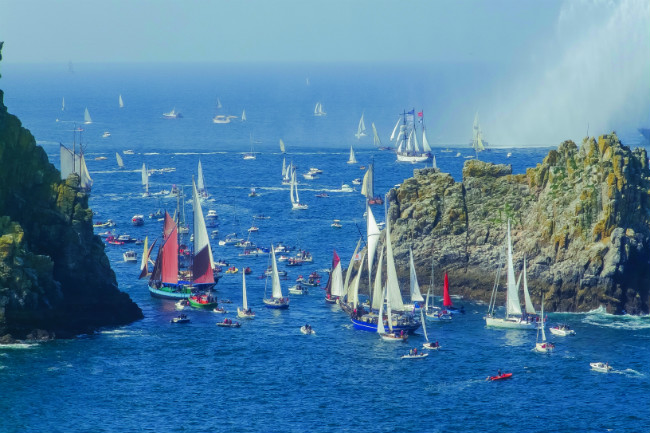
Brittany is the land of terre et mer, land and sea, green and blue. Whether you want to explore and try new adventures, or simply unwind and relax, there is room enough here to get away from it all and find what you are looking for. Annaliza Davis discovers a region that is resolutely different from its neighbours, with a slower pace of life and a rich cultural identity all its own.
The north-west arm of France has a clear identity, distinct from the rest of the country. Comprising four départements – Côtes-d’Armor (22), Finistère (29), Ille-et-Vilaine (35) and Morbihan (56) – this region is renowned for its incredible natural beauty of bright blue seas and rich green countryside.
Brittany has an impressively diverse coastline including everything from rocky cliffs to glorious sandy beaches that put other regions to shame. Some of the clearest, most sparkling seas in France are here, and they are rarely crowded so it’s an unbeatable destination for family holidays.
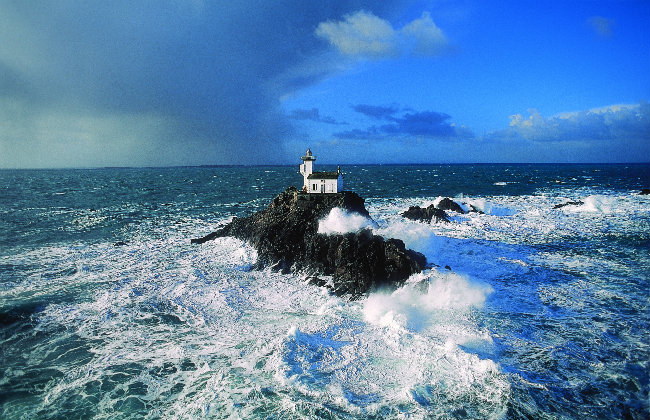
Waves crashing around a lighthouse in Brittany. Photo: CRTB/ Yannick Gal
One of the most picturesque stretches of coastline is the aptly-named Pink Granite Coast, located to the north between Perros Guirec and Ploumanac’h. This area has distinctive, rose-tinted rocks shaped by the sea into stunning formations – and they are even more awe-inspiring at sunset. Out west, the Pointe du Raz is Brittany’s equivalent of Land’s End, with unparalleled views across the Atlantic that are popular with walkers and photographers. Come off-season to experience the thrilling, crashing waves that shape these granite cliffs.
As for beaches, try the flat expanse of Pentrez beach on the Crozon peninsula, where you can enjoy sand-yachting at high speeds, the Plage Les Grèves d’en Bas near Plévenon, the long, sandy beaches of Audierne Bay or Bénodet with their turquoise waters, Plage du Minihic near Saint-Malo, or Plage du Fogeo near Arradon. Brittany’s diverse shores also mean you can find secluded coves such as Plage de Bot Conan near Fouesnant, Plage de la Fosse near Plévenon, or Plage de Port Rhu in Quiberon. Best of all, it’s extremely rare to pay for parking at a beach in Brittany, so you can pick your spot, spread out your towel and settle in for the day!
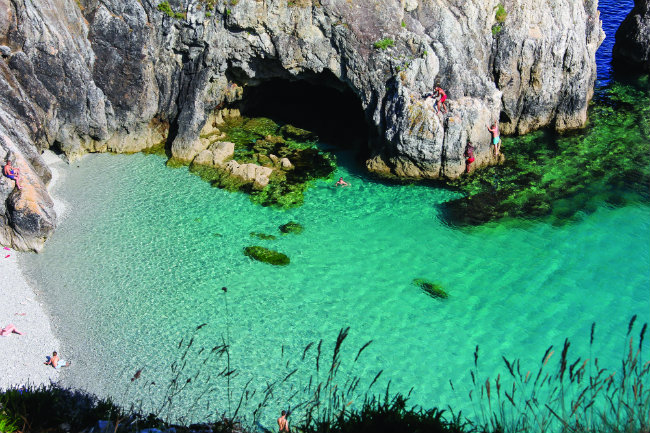
Crozon peninsula. Photo: CRTB Guillaudeau Donatienne
Splashing About
Brittany is brilliant for being out on the water. Even if you’re not near the coast, the rivers and lakes mean you’re never far from a watersport or two. This region has produced a lot of sailors and continues to train world-class competitors in elite training sites, but even schoolchildren sail here. The number of boat festivals and regattas every year confirms how important sailing is to Brittany, not to mention the visitor centre in Lorient dedicated to sailor Éric Tabarly.
To try your hand at sailing, kayaking, canoeing and more, look for Le Spot Nautique, a network of 51 spots where you can hire watersports equipment or get lessons from qualified instructors at reasonable rates, including the kit.
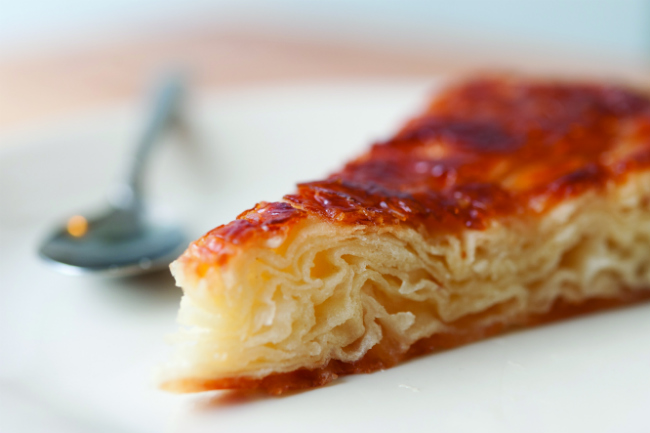
Delicious local Kouign Amann pastry. Photo: CRTB/ Emmanuel Berthier
One watersport that’s undersold in this part of France is surfing. The coast and climate here combine to create exceptional surf conditions, and it’s a favourite destination for surfers from all over Europe and beyond.
“Brittany has a major advantage when it comes to surfing,” explains Gwendal Le Cléac’h of École de Surf de Bretagne in Audierne. “It’s the only region to offer beaches suitable for beginners as well as creeks sheltered from the winds for more experienced surfers and a whole variety of surf spots so you can enjoy the sport all year round.”
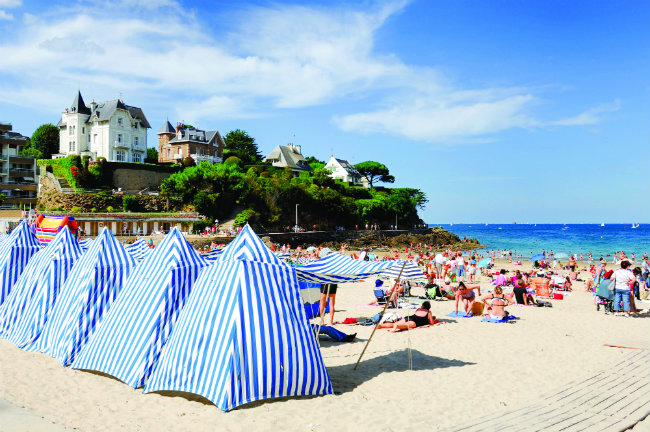
Dinard’s lovely L’Ecluse Beach. Photo: CRTB/ Yannick Gal
Historic Towns
Travelling through Brittany, some of the towns and villages seem impossibly picturesque, with blue-shuttered cottages, ancient townhouses or quaint harbours lined with bobbing boats. Rochefort-en-Terre seems too charming to be real, while visitors frequently mistake the quaint, historic town of Locronan for a permanent film set!
The region’s capital, Rennes, is tightly-packed with colourful buildings as well as classical architecture, including the stunning Parliament Palace and Opéra in an elegant square where you’ll often find artistic events and festivals – or you can relax in Rennes’ celebrated Botanic Gardens just outside the centre.
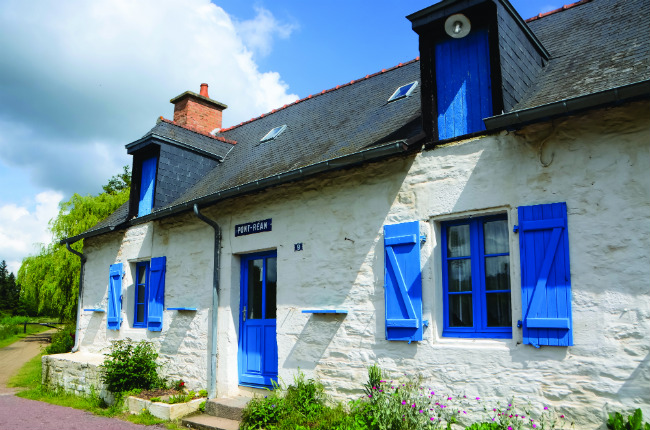
A typical rural house with blue-painted shutters. Photo: CRTB/ Jacqueline Piriou
Vannes is another photographer’s dream. Timbered buildings look set to topple over into the market place, there’s a port in the town and it’s on the edge of the Morbihan Gulf, with its islands and boat trips. Vannes is so appealing that it regularly tops any survey of places French people would most like to live.
Further west, Quimper is famous for its twin-spired cathedral, cobbled streets and the River Odet, said to be the most beautiful river in France. Linger in the cathedral square to people-watch from the cafés.
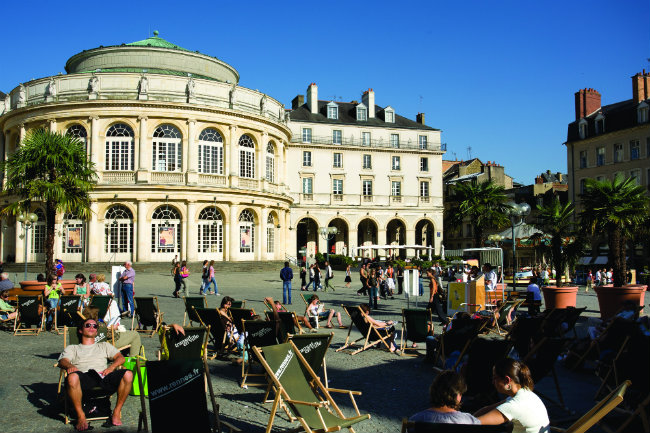
Making the most of the sun in city-centre Rennes. Photo: CRTB/ Emmanuel Berthier
On the north coast, Saint-Malo is an arrival port for many, but you should take time to venture into its centre and explore within its robust walls. Across the bay, you’ll find Dinard, a delightful highlight of this Emerald Coast, famous for dramatic palms, broad beaches, and striped beach tents. It’s a lively but rather elegant resort that’s perennially popular with Parisians and the well-to-do. Just 30km south of here, Dinan’s ramparts, panoramic views and half-timbered houses also present plenty of photo opportunities; or, a little further west, find historic Saint-Brieuc, whose cathedral and houses date to the 15th century.
With fewer ancient buildings, Lorient and Brest are major towns that played key roles in the World Wars and were heavily bombed as a result. Brest managed to keep its fortified castle, but both towns are rather modern, so although they don’t have the old-world charm of their neighbours, they are still historic.
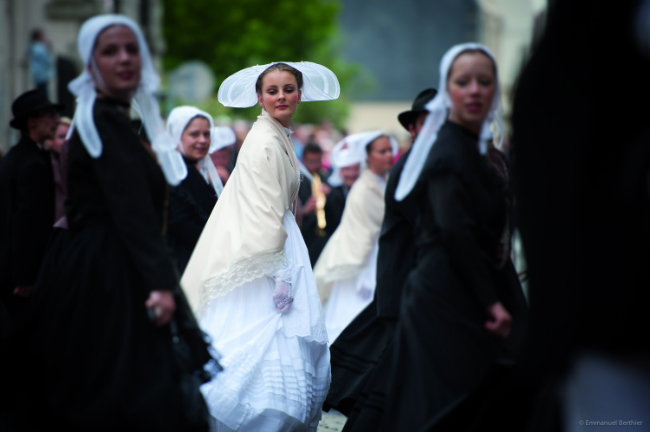
Festival de Cornouaille. Photo: CRTB/ E Berthier
Music Festivals
Music is key to Brittany’s cultural identity, through its diversity of performances and also its enthusiastic crowds. Festivals here appeal to all ages, so the result is a fantastic, multi-generational blend.
One of France’s major music events, Le Festival des Vieilles Charrues, takes place in Carhaix-Plouguer and draws major international acts and crowds of up to a quarter of a million. Le Festival du Bout du Monde takes place at ‘the edge of the world’ in the Crozon peninsula and focuses on world music, while over in Rennes, Les Tombées de la Nuit is always popular, bringing art and performance to the city centre over three weekends. For jazz fans, the ever-growing Fest’Jazz in Châteauneuf-du-Faou was started by French and British musicians and now features acts from all over the globe, as does Jazz à Vannes, which transforms the entire city into a jazz stage every year.
For more traditional festivals, Quimper’s Festival de Cornouaille attracts international names and smaller folk acts plus a parade and street performances in the streets, while the world-famous Festival Interceltique Lorient draws 800,000 people every year.
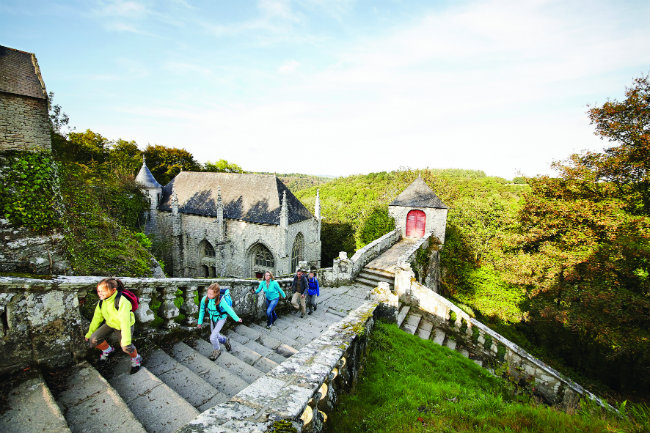
A family hike at La Faouet. Photo: Alexandre Lamoureux
Hiking, Biking and More
With its fabulous and varied landscapes, Brittany is a haven for walkers and hikers, particularly thanks to the GR34 coastal path, also known as the Sentier des Douaniers (the Customs Officers’ Path). Originally established in 1791 to enable look-out guards to spot smugglers, this path stretches for 1,800km along Brittany’s coasts, a challenging trail but highly rewarding as the views are exceptional, and many walkers return to tackle a new section each year.
Inland, you can pick up the world-famous Camino de Santiago, also known as The Way of Saint James. Leaving from Locquirec, The Way crosses the Arrée Mountains on its way south. If you follow it for 1,927km you’ll end up in Santiago de Compostela in Spain.
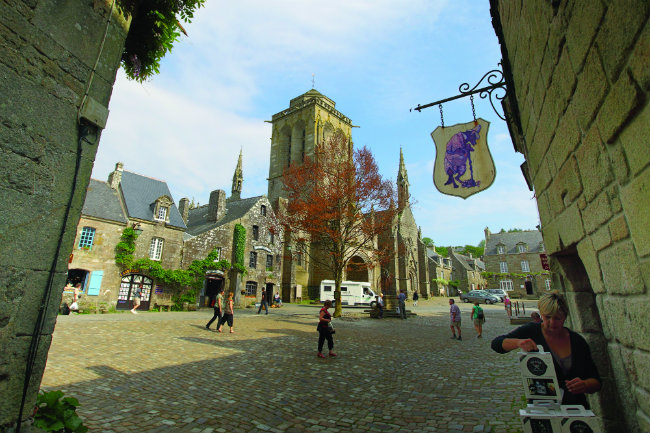
The village of Locronan. Photo: CRTB/ Pierre Torset
Alternatively, follow the extensive network of Green Ways, known here as Les Voies Vertes. These paths are designated for non-motorised vehicles, so there are no cars or motorbikes, only walkers, cyclists or horse-riders, and because most Green Ways were created using former railway tracks, they are generally flat and easy to access, making them ideal for a family outing.
Of course, France loves cyclists. Throughout the region, you’ll find mountain-bike trails, cycle paths and rental points where you can hire all types of two-wheelers, including electric bikes for getting up hills!
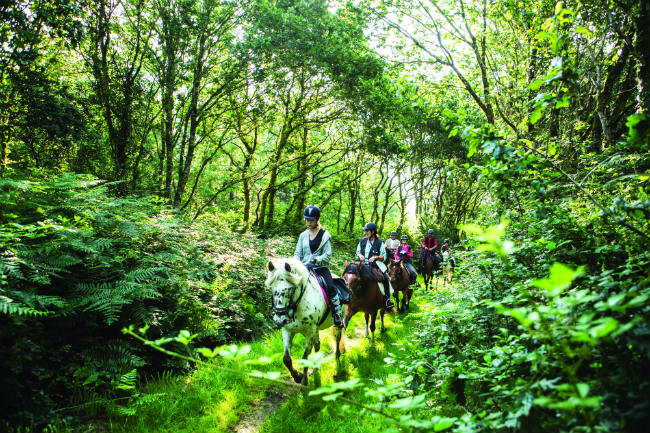
Enjoying one of Brittany’s horse-riding trails. Photo: CRTB/ Simon Bourcier
Inland Waterways
Even inland, you needn’t be far from the water as this region is threaded with streams and navigable waterways. The Canal d’Ille-et-Rance connects Saint-Malo to Rennes, but the best-known is the Nantes-Brest canal, which, as its name suggests, stretches from Brest in the north-west to Nantes further south. Covering 365km, you’d need a week to cycle the paths, or you could hire a boat, passing through lovely spots like Redon, Josselin and Malestroit, enjoying the slow navigation, leafy shade and birdsong.
Rivers are also everywhere in Brittany, from the Odet to the Auray, the Trieux to the Couesnon. There are often boat trips to enjoy along these picturesque waterways, which is a fine way to explore with minimum effort. Look out for vedettes, a word often used to describe pleasure boats.
Also look out for lakes if you’re staying inland, particularly the vast and beautiful Lac de Guerlédan in Finistère. Most of Brittany’s lakes offer water sports, surrounding paths and places to relax on the large banks, which are called plages, just like beaches.
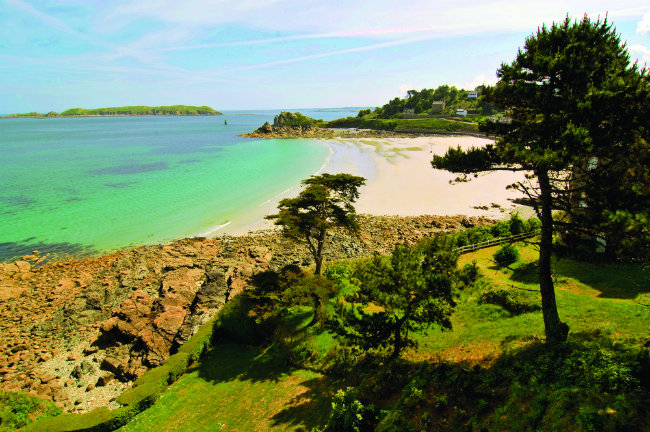
The beautiful beaches of Brittany. Photo: CRTB/ Yoann Segalen
Island-Hopping Heaven
Oven overlooked, Brittany’s islands are an absolute highlight. To the north, there is Bréhat, 10 minutes from Paimpol and, off the Pink Granite Coast, the archipelago of Les Sept-Îles, whose largest island is Île-aux-Moines.
If you’re staying near Roscoff, the Île-de-Batz is well worth the 15-minute boat trip as it’s small enough to enjoy in a day, and has its own botanical garden.
Off the western coast, you’ll find Ouessant and Molène, rather wild and natural sites, but not as eccentric as the far-flung Île-de-Sein, over an hour’s crossing from Audierne. This tiny, car-free island is a microcosm of Breton resilience, battered by the elements but still stunning, especially if you have the chance to visit off-season.
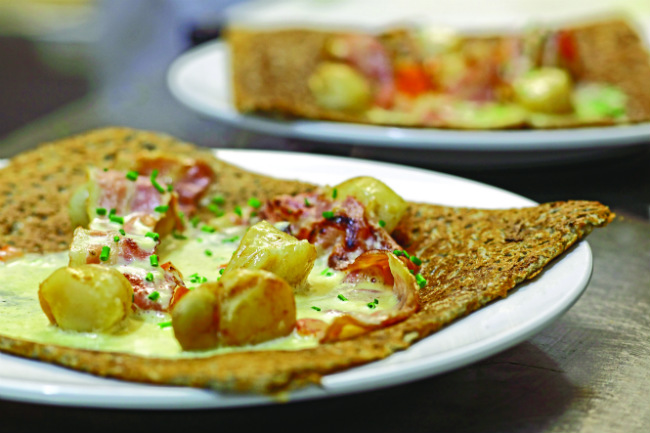
Eating crepes in Brittany. Photo: CRTB/ Pierre Torset
Moving around the coast, near Vannes is the Archipel des Glénan, where you can enjoy tropical-turquoise waters and amazing beaches, and even tour the islands in a glass-bottomed boat. Also off Morbihan’s coast is Brittany’s largest island, Belle-Île, as beautiful as its name suggests, and with coloured houses and 60 beaches. Other Morbihan islands include the Île de Groix, Houat and Hoëdic, each accessible to visitors, and each with its own island charm.
If you are travelling with children, share the magical experience of walking to an island at low tide, such as Île Callot near Carantec, Île Conleau near Vannes, Île du Guesclin north-west of Cancale or on a guided visit to Île Tristan in Douarnenez. Before leaving, check the tide times so you don’t get stranded, then enjoy the sensation of watching the waters rise to temporarily cut off your path!
Come and Look
Brittany is not a showy, boastful region, yet here, you will find everything from adrenaline-pumping activities to peaceful, relaxing beaches, from shopping malls to prehistoric sites and from raucous festivals to night markets. Whatever you’re hoping for from your holiday, it’s probably here waiting for you – all you need to do is come and look.
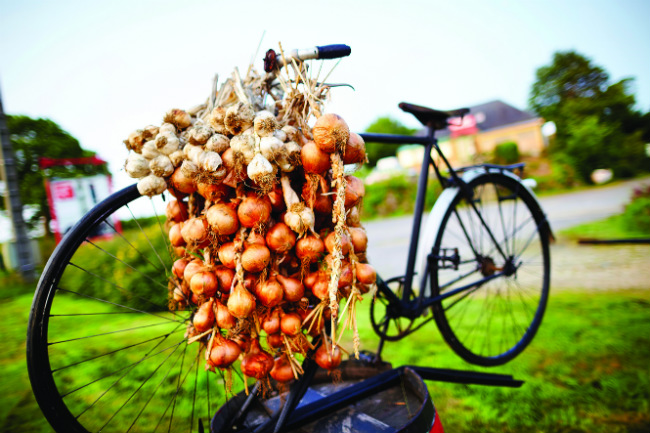
Brittany’s famous pink onions. Photo: CRTB/ Alexandre Lamoureux
Brittany’s Food and Drink
The top regional speciality is the crêpe – many visitors imagine that crêpes are only a snack, but a three-course meal in a crêperie will soon change your mind. Brittany’s typical pancakes are thin and crispy on the edges, succulently soft towards the centre, but you’ll also see galettes de blé noir, savoury crêpes made using buckwheat flour. Other sweet specialities include Far Breton (like a heavy egg-custard) and Kouign Amann, a delicious, caramelised combination of butter, sugar and flaky dough.
Of course, Brittany’s extensive coastline means fantastic seafood, including mussels and oysters, but particularly langoustines – mini-lobster that we know as scampi – served in their dainty pink shells.
Also an agricultural region, Brittany grows a large proportion of the country’s vegetables, notably Roscoff pink onions, which flourish in this climate, as do the Plougastel strawberries, which you’ll see in markets throughout Brittany and are irresistibly delicious.
Finally, a word on the region’s beverages. This is not a major wine-producing area, but the abundant apples mean that Brittany is renowned for its splendid cider, apple juice and apple-based spirits such as chouchenn and lambig. Look out for cider farms offering visits and tasting sessions – if you dare!
Brittany Essentials
GETTING THERE
By Sea: Brittany Ferries sail daily from the UK to Roscoff and Saint-Malo.
By Train: Paris to Rennes takes about 2 hours.
By Car: The A84 will take you to Brittany without detouring through Paris.
By Plane: There are UK connections at Rennes, Dinard, Brest, Quimper and Nantes.
From France Today magazine
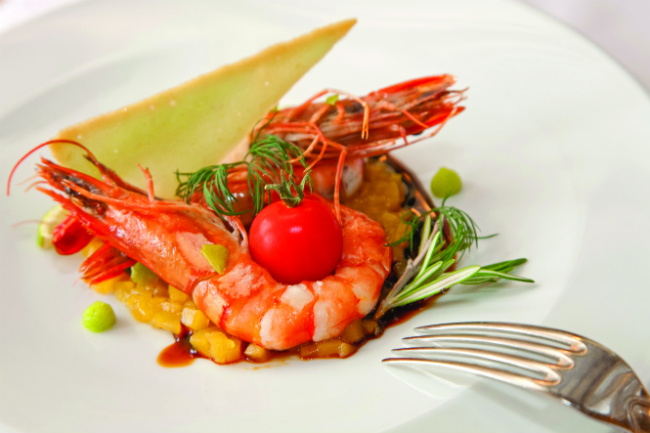
Eating langoustines in Brittany. Photo: CRTB/ Franck Hamel
Share to: Facebook Twitter LinkedIn Email
Leave a reply
Your email address will not be published. Required fields are marked *




REPLY